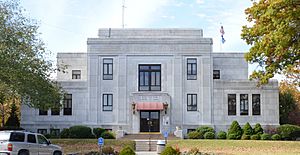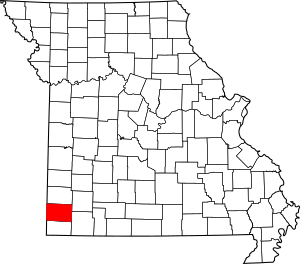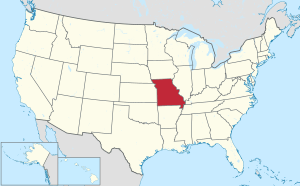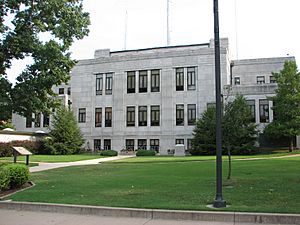Newton County, Missouri facts for kids
Quick facts for kids
Newton County
|
|
|---|---|

Newton County Courthouse in Neosho
|
|

Location within the U.S. state of Missouri
|
|
 Missouri's location within the U.S. |
|
| Country | |
| State | |
| Founded | December 15, 1838 |
| Seat | Neosho |
| Largest city | Joplin |
| Area | |
| • Total | 627 sq mi (1,620 km2) |
| • Land | 625 sq mi (1,620 km2) |
| • Water | 1.8 sq mi (5 km2) 0.3% |
| Population
(2020)
|
|
| • Total | 58,648 |
| • Density | 93.54/sq mi (36.115/km2) |
| Time zone | UTC−6 (Central) |
| • Summer (DST) | UTC−5 (CDT) |
| Congressional district | 7th |
Newton County is a county in the southwest part of Missouri. It's like a special area within the state. In 2020, about 58,648 people lived here.
The main town, or county seat, is Neosho. This is where the county government offices are. Newton County was started in 1838. It was named after John Newton. He was a brave hero who fought in the Revolutionary War.
Newton County is also part of the Joplin area. This is called the Joplin Metropolitan Statistical Area. It means Joplin and the nearby counties are connected.
Contents
Geography
Newton County covers a total area of about 627 square miles. Most of this area, 625 square miles, is land. The rest, about 1.8 square miles, is water.
Neighboring Counties
Newton County shares borders with several other counties:
- Jasper County (to the north)
- Lawrence County (to the northeast)
- Barry County (to the southeast)
- McDonald County (to the south)
- Ottawa County, Oklahoma (to the west)
- Cherokee County, Kansas (to the northwest)
Rivers and Creeks
Newton County has many rivers and creeks. They cover about 361 acres of water. The total length of these waterways is about 70 miles.
|
|
|
Main Roads
Many important roads run through Newton County:
 Interstate 44
Interstate 44 Interstate 49
Interstate 49 U.S. Route 60
U.S. Route 60 U.S. Route 71
U.S. Route 71 Route 43
Route 43 Route 59
Route 59 Route 86
Route 86 Route 175
Route 175
Public Transport
- Jefferson Lines provides bus services.
Protected Areas
- George Washington Carver National Monument is located in the county. It honors the famous scientist and inventor.
Population Information
| Historical population | |||
|---|---|---|---|
| Census | Pop. | %± | |
| 1840 | 8,790 | — | |
| 1850 | 4,268 | −51.4% | |
| 1860 | 9,319 | 118.3% | |
| 1870 | 12,821 | 37.6% | |
| 1880 | 18,947 | 47.8% | |
| 1890 | 22,108 | 16.7% | |
| 1900 | 27,001 | 22.1% | |
| 1910 | 27,136 | 0.5% | |
| 1920 | 24,886 | −8.3% | |
| 1930 | 26,959 | 8.3% | |
| 1940 | 29,039 | 7.7% | |
| 1950 | 28,240 | −2.8% | |
| 1960 | 30,093 | 6.6% | |
| 1970 | 32,901 | 9.3% | |
| 1980 | 40,555 | 23.3% | |
| 1990 | 44,445 | 9.6% | |
| 2000 | 52,636 | 18.4% | |
| 2010 | 58,114 | 10.4% | |
| 2020 | 58,648 | 0.9% | |
| 2022 (est.) | 60,011 | 3.3% | |
| U.S. Decennial Census 1790-1960 1900-1990 1990-2000 2010 |
|||
The population of Newton County has grown a lot over the years. In 1840, there were 8,790 people. By 2020, the population had grown to 58,648.
2020 Census Data
The 2020 census showed the following breakdown of people living in Newton County:
| Race | Num. | Perc. |
|---|---|---|
| White (NH) | 47,551 | 81.1% |
| Black or African American (NH) | 523 | 0.9% |
| Native American (NH) | 1,351 | 2.3% |
| Asian (NH) | 798 | 1.36% |
| Pacific Islander (NH) | 790 | 1.35% |
| Other/Mixed (NH) | 4,028 | 6.9% |
| Hispanic or Latino | 3,607 | 6.15% |
Education
Newton County has many school districts. These districts cover different parts of the county. Some even have schools in other counties.
- Carl Junction R-I School District
- Diamond R-IV School District
- East Newton County R-VI School District
- Joplin School District
- McDonald County R-I School District
- Neosho R-V School District
- Pierce City R-VI School District
- Sarcoxie R-II School District
- Seneca R-VII School District
- Wheaton R-III School District
There is also one elementary school district:
- Westview C-6 School District
Public Schools
Here are some of the public schools in Newton County:
- East Newton County R-VI School District – Granby
- Granby Elementary School (Kindergarten to 4th grade)
- Triway Elementary School (Kindergarten to 4th grade) – Stella
- Granby Junior High School (5th to 8th grade)
- Triway Junior High School (5th to 8th grade)
- East Newton County High School (9th to 12th grade)
- Diamond R-IV School District – Diamond
- Diamond Elementary School (Preschool to 4th grade)
- Diamond Middle School (5th to 8th grade)
- Diamond High School (9th to 12th grade)
- Neosho R-V School District – Neosho
- Field Early Childhood Center (Preschool)
- Benton Elementary School (Kindergarten to 4th grade)
- Central Elementary School (Kindergarten to 4th grade)
- George Washington Carver Elementary School (Kindergarten to 4th grade)
- Goodman Elementary School (Kindergarten to 4th grade)
- South Elementary School (Kindergarten to 4th grade)
- Westview Elementary School (Kindergarten to 7th grade)
- Neosho Middle School (5th to 7th grade)
- Neosho Junior High School (8th grade)
- Neosho High School (9th to 12th grade)
- Central Campus Alternative High School (9th to 12th grade)
- Seneca R-VII School District – Seneca
- Seneca Elementary School (Preschool to 5th grade)
- Iva E. Wells Middle School (6th to 8th grade)
- Seneca High School (9th to 12th grade)
Private Schools
- A private school in Neosho (Kindergarten to 12th grade) is linked to the Churches of Christ.
- Another private school in Neosho (Preschool to 12th grade) is Ozark Christian Academy, which is Pentecostal.
- Racine Apostolic Christian School in Racine (Preschool to 12th grade) is also Pentecostal.
- Trinity Learning Center in Neosho (Kindergarten to 12th grade) is Protestant.
Higher Education
- Crowder College in Neosho is a two-year college.
Public Libraries
- The Neosho/Newton County Library serves the community.
Communities
Newton County has several different types of communities.
Cities
Villages
Unincorporated Communities
These are places that are not officially part of a city or village.
Townships
Townships are smaller divisions of the county.
- Benton
- Berwick
- Buffalo
- Dayton
- Five Mile
- Franklin
- Granby
- Marion
- Neosho
- Newtonia
- Seneca
- Shoal Creek
- Van Buren
- West Benton
See also
 In Spanish: Condado de Newton (Misuri) para niños
In Spanish: Condado de Newton (Misuri) para niños


